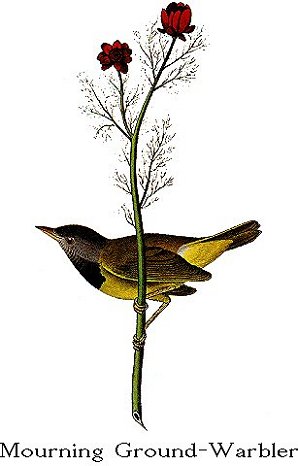
| Family VIII. SYLVICOLINAE. WOOD-WARBLERS. GENUS III. TRICHAS, Swains. GROUND-WARBLER. |
Next >> |

Family |
MOURNING GROUND-WARBLER. [MacGillivray's Warbler (see also Macgillivray's Ground-Warbler).] |
| Genus | TRICHAS PHILADELPHIA, Wils. [Oporornis tolmiei.] |
Although this beautiful species has been met with in various portions of
our eastern maritime districts, it cannot be said to be an abundant one; and no
one has, as yet, been able to discover its nest. Several of my ornithological
friends have supplied me with specimens procured in the neighbourhood of New
York, Philadelphia, and in the mountainous parts of Vermont; all these were
found during the spring and summer months, none having been seen during the
autumn; where, on the contrary, the Connecticut Warbler is plentiful.
The habits of the Mourning Warbler resemble, considerably, those of the
Maryland Yellow-throat, and other birds of the genus trichas, keeping in low
thickets, among the branches of which it hops, as well as on the ground. Its
flight also resembles that of the bird above mentioned. So curiously and
cautiously does it pass from south to north, and from north to south, that its
migratory movements have eluded the most attentive observers. My friend the
Rev. JOHN BACHMAN never has seen it in South Carolina; and in one instance only,
have I met with it in Louisiana. The figure represents a fine adult male iii
perfect plumage.
MOURNING WARBLER, Sylvia Philadelphia, Wils. Amer. Orn., vol. ii. p. 101.
SYLVIA PHILADELPHIA, Bonap. Syn., p. 85.
MOURNING WARBLER, Sylvia Philadelphia, Nutt. Man., vol. i. p. 404.
MOURNING WARBLER, Sylvia Philadelphia, Aud. Orn. Biog., vol. v. p. 79.
Bill short, straight, conico-subulate, compressed toward the end, acute;
upper mandible with the dorsal line declinate, straight, a little convex at the
end, the ridge narrow, the sides convex, the edges direct and overlapping, with
a slight notch, the tip narrow; lower mandible with the angle of moderate length
and narrow, the dorsal line ascending and slightly convex, the sides rounded,
the edges inflected, the tip acute; the gape-line straight. Nostrils basal,
lateral, operculate, exposed.
Head of moderate size, ovato-oblong; neck short; body rather slender; feet
rather long; tarsus slender, longer than the middle toe, much compressed,
covered before with seven scutella, behind with two longitudinal plates meeting
so as to form a thin edge; the lateral toes meeting so as to form a thin edge;
the lateral toes nearly equal, the third much longer, and united at the base to
the fourth, hind toe stronger and rather large; claws moderately arched,
extremely compressed, laterally grooved, acute.
Plumage soft and blended, with little gloss; wings of moderate length,
somewhat concave; the second, third, and fourth primaries having the outer web
cut out toward the end; the second quill is longest, the third scarcely a
quarter of the twelfth of an inch shorter, the fourth half a twelfth shorter
than the third, and a quarter of a twelfth shorter than the first; the other
primaries slowly graduated, the longest or second being only eight and a half
twelfths longer than the first secondary. All the quills, primary as well as
secondary, are rounded; and there are only nine primaries. Tail rather long,
considerably rounded, the lateral feathers a quarter of an inch shorter than the
middle, which are longest; all the feathers rather narrow and obliquely pointed.
Upper mandible brownish-black, its edges in their whole length pale
yellowish flesh-colour, as is the lower mandible, which, however, is a little
dusky at the end. Iris hazel. Feet and claws flesh-coloured. The upper part
of the head, the hind part and sides of the neck, are deep ash-grey, tinged with
blue; the back, scapulars, and rump deep olive-green; the wings and tail
greyish-brown, the edge of the wing and the outer margin of the first quill
bright yellow, the other primaries narrowly edged with greenish-yellow, the
secondaries of a paler brown externally, as are the tail-feathers. From the
ridge of the upper mandible to the eye is a rather broad band of black, which
extends a little way under the eye, but is not nearly so conspicuous as that of
the species above described; nor are the eyelids marked with white, their
marginal feathers being all dusky grey. The fore part of the neck and a portion
of the breast, to the distance of an inch and five-twelfths from the bill, are
deep black, with lunulate white markings, each feather being margined with that
colour; the white edges of the lower black feathers being extremely narrow leave
a crescent of nearly pure black; the breast, abdomen, lower tail-coverts, and
lower wing-coverts are bright yellow, the sides of the body yellowish-green.
Length to end of tail 5 inches; "extent of wings 8;" bill along the ridge
(5 1/4)/12, along the edge of lower mandible (7 3/4)/12; wing from flexure
2 7/12; tail 2 1/12; tarsus 9/12; hind toe (3 1/4)/12, its claw (3 1/4)/12;
middle toe 6/12, its claw (2 1/2)/12.
FLOS-ADONIS.
ADONIS AUTUMNALIS, Linn., Sp. Pl., p. 771. Willd. Sp. Pl., vol. ii.
p. 1304. Smith,. Engl. Fl., vol. iii. p. 43.--POLYANDRIA PENTAGYNIA,
Linn.--RANUNCULACEAE, Juss.
This plant, vulgarly named Pheasant's-eye, grows in Louisiana and Europe in
the cornfields. It has an erect, branched stem, with copiously pinnatifid,
alternate, sessile, dark green leaves, the segments of which are linear and
acute, and deep crimson flowers, having a black spot near the claw of each of
the petals, which vary from six to ten.
| Next >> |